Sonny James
Level III Certified Infrared Thermographer,Owner, Senior Instructor,Managing Director
NDE Institute of Trinidad Ltd./ Thermal Diagnostics Ltd.
15 Robertson Street, Les Efforts East, San Ferando, Trinidad &Tobago,West IndiesPh: 868-653-9343 / 868-657-6572www.learnndt.comwww.tdlir.com
Abstract
The condition of a power generation plant’s generator stator cores is an important consideration any time repair work is to be carried out on a generator. Downtime of the generator must be kept to a minimum and there is no room for errors or unforeseen problems prior to start up. Finding all areas on the stator core that can result in premature failure is imperative before the unit is reassembled and put back into service. This paper will discuss several case studies where both loop tests using Thermography and ELCID tests were carried out on gas and steam generator stator cores for the purpose of identifying laminations and winding shorts. This paper also discusses the method of repairs and re-inspections that were performed after problems were identified.
With Thermographic images of actual stator core faults both before and after repairs and comparisons with ELCID testing, this paper will benefit all in the generator maintenance and inspection field. It also serves as a good training tool for thermographers who wish to perform this type service.
Introduction
In power generation, an electric generator is a device that converts mechanical energy into electrical energy. This is possible because of electromagnetism or electromagnetic induction. In simple terms, a changing magnetic field generates an electric field. So, to generate electricity you usually need a mechanical force to generate a changing magnetic field which will generate an electrical field that forces electrons in the windings of the generator to flow through the external electrical circuit.
You can think of an electric generator and how it is driven as the opposite of a motor and pump combination. For example, in a process plant, electricity provides the power needed to spin a motor, by taking the electrical energy and converting it to a changing magnetic energy via the rotor and stator. Then this magnetic force is converted to mechanical force (kinetic energy) that spins the impeller of the pump that sucks and pushes the water or fluid out.
In a hydroelectric power plant example, we start with the mechanical force of moving water that spins a turbine and the turbine spins the generator. The generator takes this mechanical force and converts it into a changing magnetic force. This changing magnetic force generates an electrical field, and voila.
Apart from water, there are other driving forces used to spin the generator such as, steam, gas, and wind turbines.
A key component of the generator is the stator. The stator is made up essentially of windings and an iron core.
An iron core can develop core losses because of winding failure, aging and deterioration due to heat. Iron cores are made of thin laminated steel sheets. These laminations can become “shorted” or joined together when there is failure in the windings, bearings and general deterioration of the insulation. This deterioration is accelerated by increased temperature. Winding failure can weld or blow holes in the core.
Generator stators are extremely expensive and are not easily or quickly replaceable or repairable. So anytime stator repairs are carried out, it is in the best interest of the owner to be sure that all repairs are done correctly and that all critical shorts are caught and repaired before the unit is reassembled and put back into operation.
Quality Control Technologies
Two extremely useful testing technologies used for quality control of stator repairs are Loop tests (Ring Flux tests) with Thermography and Electromagnetic Core Imperfection Detector or ELCID. Both have their advantages and also their limitations and thus compliment each other perfectly.
The Loop test involves exciting or fluxing the stator core to, or near to, the full rated flux of the generator by means of several turns of a high voltage insulated winding through the bore and around the outside of the stator. This induced flux produces fault currents similar to when the generator is in operation. If shorts are present, this will result in localized heating. This localized heating can then be seen with a thermal camera, pinpointing the exact location to be repaired.
Caution should be used during this test to not produce temperature rises which can cause further damage to the stator core.
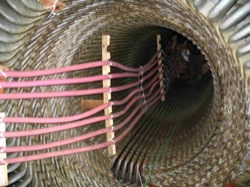 |
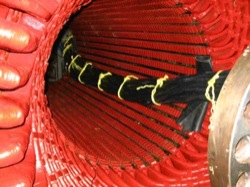 |
Images showing Loop Test setup through the stator cores
Electromagnetic Core Imperfection Detection (ELCID) test was developed as a way to readily test machines where a high power source was not available or deemed too risky. The ELCID test uses a very low flux level excitation winding that a technician would scan over the laminations. The fault current from shorts are detectable by electromagnetic means and the response is shown on a meter or oscilloscope screen.
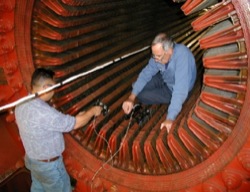 |
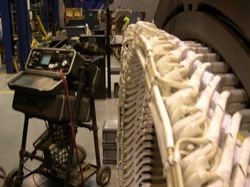 |
Images showing ELCID testing and equipment
Although ELCID is considered an easier means than the traditional Loop test of checking the integrity of stator cores, I have found many instances where critical shorts go undetected. The main reason is that this type of testing is time consuming, tedious and dependent on the technician’s skill and attentiveness. Also, because of the lower flux levels used, certain shorts do not create a fault current that can be detected by the instrument.
For this reason, I found that it is always best to use both technologies together in a tactical manner. ELCID first; carry out the repairs on the shorts found and finish off with the Loop test with Thermography to find the areas missed by ELCID. The additional time and cost of performing both tests far outweighs the cost and downtime as a result of stator burnout due to missed shorts.
Case Study #1
|
Generator Type: |
Hitachi 69MW Steam Turbine Generator (Type: TFLH) |
This particular stator had just recently suffered a failure resulting in the burning out of a series of iron packs located on the bottom of the turbine side of the stator.
An outside repair firm was hired by the customer to conduct all necessary repairs on this stator.
Prior to the thermographic survey, the damaged section of the core was repaired and tested with ELCID.
Loop Test with thermography (after ELCID testing and repairs)
 |
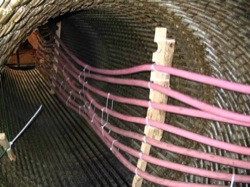 |
Image showing loop test setup from turbine and exciter sides
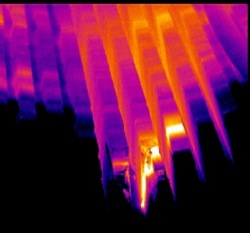 |
 |
|
 |
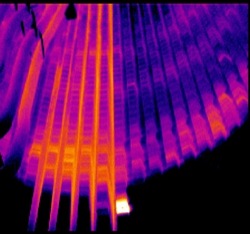 |
Images showing hot spots due to lamination shorts (missed by ELCID test)
Case Study #2
|
Generator Type: |
60MW Gas Turbine Generator (Brown Boveri Turbomachinery) |
This particular stator had suffered a failure resulting in the burning out of a series of iron packs located throughout the turbine side of the stator.
An outside repair firm was hired by the customer to conduct all necessary repairs on this stator.
Prior to the thermographic survey, the damaged sections of the core were repaired and tested with ELCID.
Initial Loop test with thermography (after ELCID testing and repairs)
 |
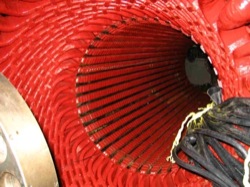 |
Image showing loop test setup from turbine and exciter sides
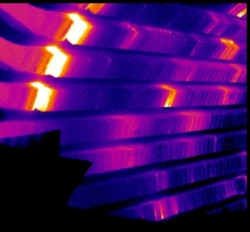 |
 |
|
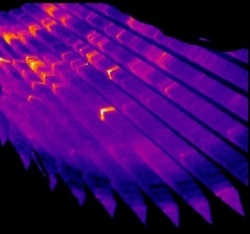 |
 |
Images showing hot spots due to lamination shorts (missed by ELCID test)
Repair Work Carried Out
Shorts in laminations were easily repaired by attempting to carefully separate the lamination with the use of a knife or other suitable tool or by grinding out the short area with a pencil grinder while still staying within the acceptable limits.
Second Loop test with thermography after repairs
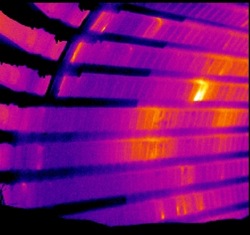 |
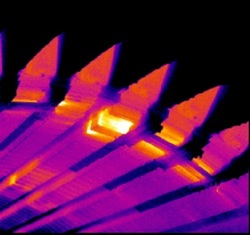 |
|
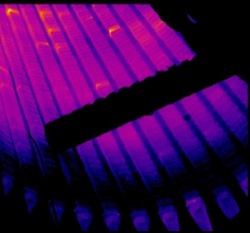 |
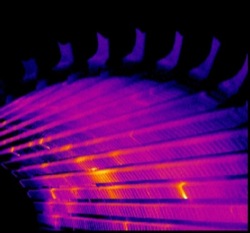 |
Images showing hot spots due to lamination shorts (missed by ELCID test)
Conclusion
The use of thermographic imaging is an invaluable tool for finding critical stator core windings and lamination shorts. Although in some countries and industries, using ELCID testing may be the preferred method due to its use of low fluxing levels, using one testing technology alone is not advisable as can be clearly seen with the above case studies. Loop testing with Thermography should be strongly considered as an addition to ELCID (not a replacement) to ensure proper quality control of generator stator repair works. Thermographic imaging of stator cores is extremely fast and effective and very cost efficient.
Because thermographic images are permanent records that can be saved and radiometrically analyzed at any time, it can also act as a quantifiable means of documenting the quality of the generator stator before it is put back into service. This additional advantage over ELCID makes it beneficial for trending purposes as well as avoiding failures and business interruption losses.
Don’t Fall “Short” of Your “Core” Objectives! Thermography Just Makes Sense!
References
ELCID testing image: SIM International, Toronto, ON M9R 1T2, Canada, www.siminternational.ca
ELCID testing equipment image: Maine Industrial Repair Services, Inc, Augusta, ME 04330, USA,www.maineindustrial.com



